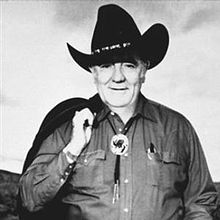Did I really have something in common with the legendary Louis L’Amour? See what you think in this post, first presented in 2013.
 Earlier this year I received a gift from my cover artist and good friend in Shingle Springs, California, Karen Phillips—a used copy of a Louis L’Amour novel titled, The Haunted Mesa. Seems Karen had picked it up at a thrift shop and, as she wrote, “…everything about it reminded me of you and your stories.” She even wondered if L’Amour and I were soul brothers. Considering that the guy published well over a hundred novels and sold gazillions of copies, I take that as high praise.
Earlier this year I received a gift from my cover artist and good friend in Shingle Springs, California, Karen Phillips—a used copy of a Louis L’Amour novel titled, The Haunted Mesa. Seems Karen had picked it up at a thrift shop and, as she wrote, “…everything about it reminded me of you and your stories.” She even wondered if L’Amour and I were soul brothers. Considering that the guy published well over a hundred novels and sold gazillions of copies, I take that as high praise.
As a kid I had read lots of L’Amour’s westerns, but to be honest, it had been many decades since I’d read anything in that genre. Still, Louis L’Amour is a household name to anyone who reads, or writes, for that matter. I even used him as a model for one of my characters, crusty western writer Jack Redmond, in my ghost story, Fire Dance. But The Haunted Mesa, published in 1987—a year before L’Amour’s death—is not a typical western in the Roy Rogers/Lone Ranger mold, despite its setting in the Four Corners area of the Southwest. I’ve seen it categorized as Fantasy, Contemporary Fiction, Science Fiction, even Weird West. Definitely worth a look on my part, especially since the story’s main focus was on the Anasazi, the remarkable Native American culture of cliff dwellers that inexplicably disappeared many hundreds of years ago.

Louis L’Amour
Quick summary: main protagonist Mike Raglan, renowned debunker of paranormal phenomena, is summoned by his friend, Erik Hokart, a wealthy eccentric who is building a house atop a creepy mesa in the Four Corners area. Something is wrong, Erik writes. When Mike arrives, he finds that Eric has disappeared. In reading Eric’s journal, Mike learns that Eric discovered a “window” between the Third and Fourth Worlds. (According to Hopi legend, the Anasazi came to this, the present-day Fourth World, from the evil Third World, but many of them returned when the window reopened.) The beautiful Indian girl, Kawasi, who delivered the journal to Mike, is from the Third World, she tells him. Her people are the peaceful cliff dwellers, but the Third World is still ruled by evil in the form of The Hand and The Voice. (Talk to The Hand? Sorry…) They also have “agents” in this world, some of whom attempt to stop Mike from his ultimate goal of entering the Third World and rescuing Erik.
The concept is fascinating, the details interesting, and the setting can’t be beat—I love this part of the country. The last 100 pages rock as Mike enters the Third World. But, to paraphrase more than one reviewer, it takes L’Amour over 250 pages to have his character talk about and internalize what he’s going to do to save his friend, and 100 pages to SHOW him doing it. These were my sentiments exactly—before I read any of the old reviews. I always have my editor’s hat on (a curse, sometimes), and I thought there was way too much exposition. Karen Phillips, in addition to doing my covers, is also one of my writers, and in her accompanying note she said, “It’s a good read, although repetitive, and he sure could have used you as his editor!” Guess I taught her well about unnecessary exposition.
Still, The Haunted Mesa is an entertaining and interesting read, written by a master storyteller. And remember, you can always skim past the heavy exposition. (I learned that trick reading Tom Clancy.)

I also enjoyed Haunted Mesa despite the weird exposition problem. What I found most interesting about the exposition was that it repeated itself so much; I’m sure it was very realistic, in a situation like that you would think about what you know over and over again trying to make sense of it. But the style was so unlike every other L’Amour book I’ve read; he’d always been extremely terse. If something needs to be said, a L’Amour hero only needs to say it once.
Good points. One excuse might be that he wrote this book a year or so before he died, so he was quite long in tooth. Also, his editor probably decided that, since the author was a legend, he wouldn’t change too much of his prose. In any case, the core story was pretty cool.